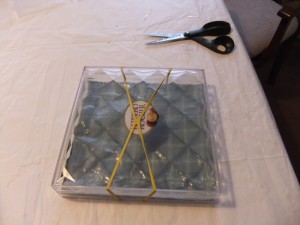Acrylic paint has all kinds of benefits and a few disadvantages, some of which are touched on in the article “Acrylic Painting” , but the facet of acrylic that I will deal with here is the speed at which the paint dries.
Fast……that’s the speed……very fast. It is possible to add a medium that will slow it down to just “quite quick”, but even that will not allow you to leave your brushes with paint on them for long. So…..I’d say that acrylic paint has 2 speeds of drying and they are “fast” and “even faster”
I will cover brush cleaning properly at another time (for the time being just put your brushes in water if you are to be away for more than 30 seconds or you’ll come back to find an expensive stick where there used to be a brush) This page will deal with how to get the best from the paint that you put onto your palette…….because it too will just go and dry in quick time.
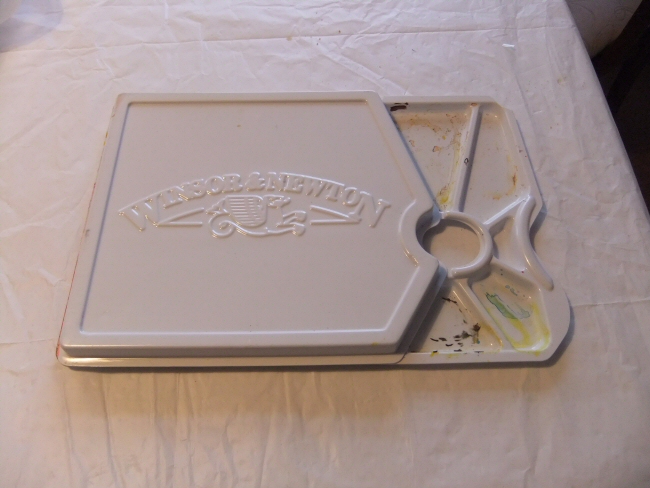 You can buy a device called a Stay Wet Palette which can cost anywhere between £10 and £30 or more. The photo on the left is of one that I bought some time ago. You can see that it is a little battle scarred with use (ie it needs a good cleaning) I bought this because no one had told me that I could make one so easily for virtually no cost!! Oh the tears that I cried over the wasted expenditure. Free….who doesn’t like Free?
You can buy a device called a Stay Wet Palette which can cost anywhere between £10 and £30 or more. The photo on the left is of one that I bought some time ago. You can see that it is a little battle scarred with use (ie it needs a good cleaning) I bought this because no one had told me that I could make one so easily for virtually no cost!! Oh the tears that I cried over the wasted expenditure. Free….who doesn’t like Free?
So…what do you need?……well, a flat (or 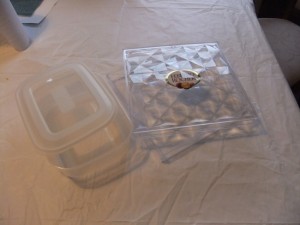 fairly flat) container. Here I have shown two containers that come free. One is an old “tupperware” type container and the other is an empty case from “Ferrero Rocher”. You can also use the seal-able containers that you get with your take-away but you may need to have a couple of these as they can be a bit on the small side. It might be worth considering anyway so that you could have a separate one for each colour or colour mix (as long as you have a limited number of colours in use)
fairly flat) container. Here I have shown two containers that come free. One is an old “tupperware” type container and the other is an empty case from “Ferrero Rocher”. You can also use the seal-able containers that you get with your take-away but you may need to have a couple of these as they can be a bit on the small side. It might be worth considering anyway so that you could have a separate one for each colour or colour mix (as long as you have a limited number of colours in use)
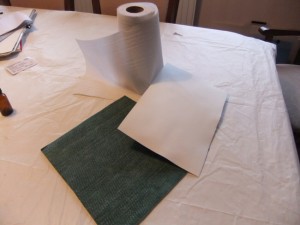 So……now you need a “water reservoir” ie some medium that can hold on to the water that we will add to this later. This water will create a moist micro-climate that will slow down the rate of drying of the acrylic paint.
So……now you need a “water reservoir” ie some medium that can hold on to the water that we will add to this later. This water will create a moist micro-climate that will slow down the rate of drying of the acrylic paint.
Lots of different materials may be used here. I have shown just 3…..ie kitchen towel (which should be added 2 or 3 ply thick), or (as suggested by our own Bernard) capillary matting, beloved of gardeners, which I’m told is quite cheap and will hold lots of water, “J Cloths”, and finally you may use a piece of watercolour paper. This would be the chance of using that cheap watercolour paper (typically 90lb) that you bought in error and have found is useless to paint on. Any absorbent material will do in fact.
Now we need a membrane that will separate 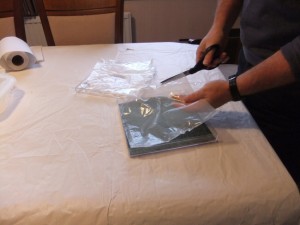 the paint from the water reservoir. You can use kitchen greaseproof paper which is very cheap or, and thanks to Bernard again for this, you can use the inner wrapper from a cereal box (it’s useful if you wait until you’ve used all the cereal as otherwise your cornflakes will end up all soggy) So…. trim it up and lay it on top of the water reservoir.
the paint from the water reservoir. You can use kitchen greaseproof paper which is very cheap or, and thanks to Bernard again for this, you can use the inner wrapper from a cereal box (it’s useful if you wait until you’ve used all the cereal as otherwise your cornflakes will end up all soggy) So…. trim it up and lay it on top of the water reservoir.
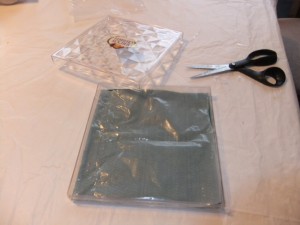 So, having cut the waterproof membrane to size and put it on top of the water reservoir element, you’re ready to go!
So, having cut the waterproof membrane to size and put it on top of the water reservoir element, you’re ready to go!
Lift up the membrane and slowly trickle water onto the paper (or whatever) beneath. Pour off any excess water and replace the membrane. You’re now ready to put your paint into the Stay Wet Palette.
Placing a tight lid on top of the box will delay the drying of the acrylic paint for an extended period. I have had no problem in using the paint as much as two weeks later. One trick to help the delay in the drying of paint is to lightly mist the top surface of it prior to putting the lid on.
 Another thing that you may wish to remember is that the stay wet palette is particularly useful for storing acrylic colour mixes. This is because it’s highly unlikely that you’ll be able to revisit your painting in a week and mix the same colour to continue work on it. Using it to store acrylic paint that came straight from the tube is clearly economically sensible but even if it had dried you could always just get some more straight from the tube……not so with the mix that you worked so hard to create…….arrrgh.
Another thing that you may wish to remember is that the stay wet palette is particularly useful for storing acrylic colour mixes. This is because it’s highly unlikely that you’ll be able to revisit your painting in a week and mix the same colour to continue work on it. Using it to store acrylic paint that came straight from the tube is clearly economically sensible but even if it had dried you could always just get some more straight from the tube……not so with the mix that you worked so hard to create…….arrrgh.
I found this out when trying to recommence the pop art painting of Clint Eastwood that I’d started at the November 2012 Community Fayre, only to discover that I couldn’t mix the correct colour and will have to repaint huge areas of my painting. I may need to lie down in a darkened room until I stop crying.

